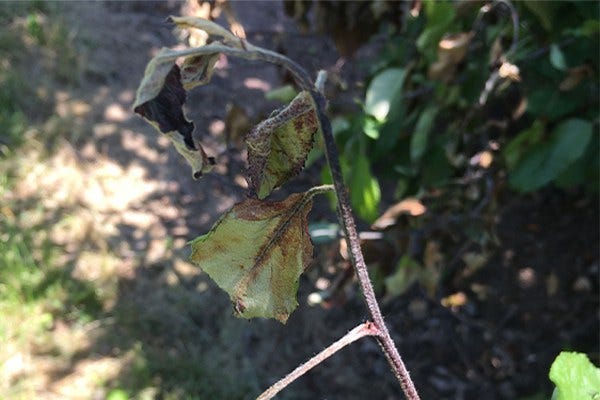"
2023 Disease Update: Scout for Fire Blight and Apple Scab Infections
We have experienced multiple infection events for fire blight and apple scab this 2023 season. Consequently, we are at a time when these infections are visible.
Updated:
May 19, 2023
Skip to the end of the images gallery

Scout for blossom blight and shoot blight in apple orchards. Photo: K. Peter, Penn State
Skip to the beginning of the images gallery
It is important that growers scout their orchards for potential infections. The earlier an infection is caught, the easier it will be to manage. During dry days, assess disease in your orchards and take remediation steps, if necessary.
Fire Blight Management
There were two significant fire blight infection events in Pennsylvania during the bloom period: April 14–16 and April 21–22. Many PA growers also had a protracted bloom due to the cool weather from late April through early May. If you experienced a protracted bloom that lasted through this past weekend, there was another good fire blight infection event on May 12–15. Consequently, it is imperative growers begin scouting their orchards this week and next week. The earlier fire blight infections are caught, the easier it is to manage the disease.
Items to keep in mind when pruning out fire blight infections:
- Do not cut out infections during wet weather since bacteria move via water.
- Cut out active infections early—before necrosis develops (limits the spread of bacteria).
- Pruning is most effective when incidence is low.
- Focus on salvaging tree structure and young high-density plantings when incidence is high.
- Bacteria can invade healthy tissue up to ~3 feet in advance of visible symptoms, which makes tool sterilization ineffective.
- Practice the ugly stub method: cut 6–12 inches below the margin of visible infection and remove later during winter pruning.
- Ideally, infected tissue should be removed from the orchard and burned. However, if pressed for time, prunings can be left in the row middles to dry out and subsequently chopped with a mower.
If you observe fire blight, consider using the “Actigard Paint” method:
- After cutting out the fire blight, apply a high concentration spray of Actigard to the cut and 1 meter of trunk below the limb with the fire blight. According to the label, mix 1 oz Actigard in 1 quart of a 1% penetrant. The penetrant suggested on the label is Pentrabark (an organosilicone); however, a similar penetrant can be used. Do not apply as a spray since the leaves will be adversely affected by the high concentration of the solution. One quart will treat approximately 500 cuts. Do not apply within 60 days of harvest.
- If infection is evident, consider an application of the highest rate of ProCa (12 oz/A) to shut down the infection spread. Another option would be three applications of ProCa (6 oz/A) + Actigard 2 oz/A.
If 2023 turns out to be a bad fire blight year, we recommend a “triage” method when it comes to pruning decisions once fire blight has struck, going from highest to lowest priority:
- Young orchards 3–8 years old with just a few strikes. (highest priority)
- Young orchards 3–8 years old with severe strikes.
- Older orchards with a few strikes.
- The “walk away” group: orchards with so many strikes that most of the tree would need to be removed; severe pruning can stimulate new growth that can become infected. (lowest priority)
Folks have been told all along to prune out fire blight during the season when they see it; however, there can be too much of a good thing: It is very important to avoid excessive cutting when pruning out fire blight. Excessive cutting will encourage more shoot growth and make your fire blight problem even worse. This is especially true for older orchards where cankers may be lurking about in the tree.
Apple Scab Management
We are at the end of the primary phase of apple scab. During this time, we experienced several scab infection events when the spore counts were high from mid-April through early May. It is important growers scout their orchards for scab infections to determine if there are any issues that need to be addressed.
To scout: For each orchard block, follow a “W shape” pattern within the block when scouting. Evaluate 10 trees by examining 20 leaves on each of 5 limbs per tree and record the number of leaves showing any scab lesions.
- Begin with the flower bud (spur) leaves, where early infections are most likely to be noticed.
- Start with observing the undersurface of leaves since the undersurface of leaves may become spotted before the top surface. Take notice of early lesions, which may be small light brown-black spots.
- As scouting continues during early spring, be sure to observe both the topside and underside of the leaf. Apple scab infection appears as brown velvety lesions, which will become darker as they age.
- After fruit has set, in addition to leaf observations, also examine 20 fruit on each tree and record the number showing any scab lesions. Use this information to better manage scab in the future.
If apple scab is observed, applications of fungicides containing FRAC Group 3 + a broad spectrum fungicide should help slow down the infection. Sulfur (8–10 lb/A) is also recommended; however, sulfur can be phytotoxic on fruit when temperatures any time during the day are 80°F or higher. It is important that any trees with scab infection be monitored regularly since scab can cause repeated infections throughout the tree once established.
Marssonina Blotch (AKA Apple Blotch)
We are not out of the woods for Marssonina blotch. The primary infection period for Marssonina Blotch is still underway. Remain vigilant to control the disease through early June to disrupt the disease cycle to limit premature defoliation later in the season. Everyone has Marssonina blotch in their orchard whether they realize it or not, so don’t let up off the gas pedal right now. Apple scab might be over, but Marssonina is in full swing.
Marssonina infection conditions are like apple scab. Research has shown that when temps are around 50°F, at least 14 hours of leaf wetness are needed; around 59 °F, at least 8 hours of leaf wetness hours are needed; and when temps are 68–77°F, ~ 4 hours of leaf wetness hours are needed. Tank mix your rainfast mancozeb with the fungicides recommended to control apple scab described above. These fungicides will also control Marssonina blotch. The most effective fungicides to control Marssonina blotch include those in FRAC Groups 3, 7, or 9. FRAC Group 11 fungicides are ineffective, which is another reason to keep these fungicides for the summer months to control fruit rots. For organic producers, growers must use sulfur during this time. Apple scab-resistant trees are HIGHLY susceptible to Marssonina blotch, and sulfur is the best organic product to control Marssonina blotch.
Bacterial Spot
We are beginning to see conditions start to favor bacterial spot on stone fruit. Management programs for susceptible stone fruit varieties (peach, nectarine, plum, apricot) should be underway and continue until about 3 weeks before harvest when preharvest brown rot management program occurs. Use copper at 0.5–1 oz of metallic copper per acre. For more information about this copper usage, please refer to Dr. Norm Lalancette’s article about copper bactericides.
Rotate copper with the following:
- Serenade ASO 4 qt/A
- Serenade Opti 14 oz/A
- Double Nickel 2 qt/A
- Regalia 2 qt/A
- Mycoshield/FireLine 12 oz/A
Memorize Six Things When Using Copper on Stone Fruit Trees!
- Copper is a general biocide: Copper will kill fungi, bacteria, AND plant cells.
- Do not tank mix copper with a foliar fertilizer or phosphorous acid product (i.e., Rampart, Phostrol, Prophyt).
- Captan and sulfur will also cause phytotoxicity (symptoms will be like copper injury).
- Copper sprays will become more phytotoxic if they are applied in an acidic solution: beware of adjuvants that lower pH of tank mixes. Growers may add lime to reduce the potential for plant damage.
- Copper phytotoxicity worsens under slow-drying conditions. Use alternative products during rainy periods.
- Copper injury causes round holes of different sizes and will appear like a spray pattern on the leaf. Defoliation can occur with repeated copper applications and is mostly observed on the oldest leaves. Bacterial spot symptoms appear as angular spots, following the veins of the leaf, resulting in yellowing and eventual defoliation.
If growers lost their crop due to the cold temperatures this spring, bacterial spot management is necessary since it can also cause premature defoliation. It is recommended that highly susceptible fruit trees without fruit be monitored for disease development on leaves and subsequent defoliation during optimal disease conditions, which are warm (75–85°F), wet, and windy. If the disease severity increases during the season, applications of oxytetracycline are recommended. If we experience a hot, dry summer, the progress of the disease will slow.
For commercial fruit growers, please note: When controlling for disease, weather and tree growth conditions need to be monitored at a local level within one’s own orchard. To assist with management decisions (especially infection events), growers can use the NEWA website, which has weather stations all over Pennsylvania. Before chemical products are applied, be sure to comply by obtaining the current usage regulations and examining the product label. Product information can be easily obtained from CDMS.
EPA Bilingual Pesticide Labeling National Webinar
The EPA has announced a public webinar/forum to discuss upcoming changes regarding pesticide label availability and accessibility to non-English speaking farm workers on Thursday, June 15, 2023, from 5:00 p.m. to 7:00 p.m. The goal is to obtain input from the public on ways to make bilingual pesticide labeling accessible to farmworkers as required by the Pesticide Registration Improvement Act of 2022 (PRIA 5). Learn more and register for this free event.
Associate Research Professor, Tree Fruit Pathology
Expertise
- Apple and pear diseases
- Peach, cherry, other stone fruit diseases
- Tree fruit disease management
